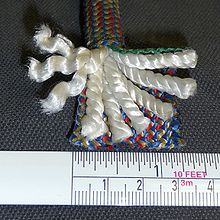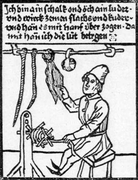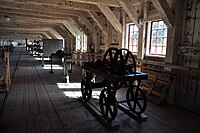User:Rhys Phelan/sandbox

A rope is a group of yarns, plies, or strands that are twisted or braided together into a larger and stronger form. Ropes have tensile strength and so can be used for dragging and lifting, but are too flexible to provide compressive strength. As a result, they cannot be used for pushing or similar compressive applications. Rope is thicker and stronger than similarly constructed cord, line, string, and twine. Fiber rope is made from fiber, whereas wire rope is made from wire.
Construction[edit]

Rope may be constructed of any long, stringy, fibrous material, but generally is constructed of certain natural or synthetic fibres. Synthetic fibre ropes are significantly stronger than their natural fibre counterparts, but also possess certain disadvantages, including slipperiness.
Common natural fibres for rope are manila hemp, hemp, feathers, linen, cotton, coir, jute, straw, and sisal. Synthetic fibres in use for rope-making include polypropylene, nylon, polyesters (e.g. PET, LCP, Vectran), polyethylene (e.g. Dyneema and Spectra), Aramids (e.g. Twaron, Technora and Kevlar) and acrylics (e.g. Dralon). Some ropes are constructed of mixtures of several fibres or use co-polymer fibres. Wire rope is made of steel or other metal alloys. Ropes have been constructed of other fibrous materials such as silk, wool, and hair, but such ropes are not generally available. Rayon is a regenerated fibre used to make decorative rope.
The twist of the strands in a twisted or braided rope serves not only to keep a rope together, but enables the rope to more evenly distribute tension among the individual strands. Without any twist in the rope, the shortest strand(s) would always be supporting a much higher proportion of the total load.
Usage[edit]

Rope is of paramount importance in fields as diverse as construction, seafaring, exploration, sports, theatre, and communications; and has been used since prehistoric times. To fasten rope, many types of knots have been invented for countless uses.[1][citation needed] Pulleys redirect the pulling force to another direction, and can create mechanical advantage so that multiple strands of rope share a load and multiply the force applied to the end. Winches and capstans are machines designed to pull ropes.
Rock climbing ropes[edit]


The modern sport of rock climbing uses so-called "dynamic" rope, which stretches under load in an elastic manner to absorb the energy required to arrest a person in free fall without generating forces high enough to injure them. Such ropes normally use a kernmantle construction, as described below. "Static" ropes, used for example in caving, rappelling, and rescue applications, are designed for minimal stretch; they are not designed to arrest free falls. The UIAA, in concert with the CEN, sets climbing-rope standards and oversees testing. Any rope bearing a GUIANA or CE certification tag is suitable for climbing. Despite the hundreds of thousands of falls climbers suffer every year, there are few recorded instances of a climbing rope breaking in a fall; the cases that do are often attributable to previous damage to, or contamination of, the rope. Climbing ropes, however, do cut easily when under load. Keeping them away from sharp rock edges is imperative.
Rock climbing ropes come with either a designation for single, double or twin use. A single rope is the most common and it is intended to be used by itself, as a single strand. Single ropes range in thickness from roughly 9mm to 11mm. Smaller ropes are lighter, but wear out faster. Double ropes are thinner ropes, usually 9mm and under, and are intended for use as a pair. These ropes offer a greater margin or security against cutting, since it is unlikely that both ropes will be cut, but they complicate belaying and leading. Double ropes are usually reserved for ice and mixed climbing, where there is need for two ropes to rappel or abseil. They are also popular among traditional climbers, and particularly in the UK, due to the ability to clip each rope into alternating pieces of protection; allowing the ropes to stay straighter and hence reduce rope drag. Twin ropes are not to be confused with doubles. When using twin ropes, both ropes are clipped into the same piece of protection, treating the two as a single strand. This would be favourable in a situation where there was a high chance of a rope being cut. However new lighter-weight ropes with greater safety have virtually replaced this type of rope.
The butterfly coil is a method of carrying a rope used by climbers where the rope remains attached to the climber and ready to be uncoiled at short notice. Another method of carrying a rope is the alpine coil.
Aerial rope[edit]
Rope is also an aerial acrobatics circus skill, where a performer makes artistic figures on a vertical suspended rope. Tricks performed on the rope are, for example, drops, rolls and hangs.They must also be strong [2] See also Corde lisse.
History[edit]

The use of ropes for hunting, pulling, fastening, attaching, carrying, lifting, and climbing dates back to prehistoric times. It is likely that the earliest "ropes" were naturally occurring lengths of plant fibre, such as vines, followed soon by the first attempts at twisting and braiding these strands together to form the first proper ropes in the modern sense of the word. Impressions of cordage found on fired clay provide evidence of string and rope-making technology in Europe dating back 28,000 years.[3] Fossilized fragments of "probably two-ply laid rope of about 7 mm diameter" were found in one of the caves at Lascaux, dating to approximately 15,000 BC.[4]
The ancient Egyptians were probably the first civilization to develop special tools to make rope. Egyptian rope dates back to 4000 to 3500 B.C. and was generally made of water reed fibres.[5] Other rope in antiquity was made from the fibres of date palms, flax, grass, papyrus, leather, or animal hair. The use of such ropes pulled by thousands of workers allowed the Egyptians to move the heavy stones required to build their monuments. Starting from approximately 2800 B.C., rope made of hemp fibres was in use in China. Rope and the craft of rope making spread throughout Asia, India, and Europe over the next several thousand years.
In the Middle Ages (from the 13th to the 18th centuries), from the British Isles to Italy, ropes were constructed in ropewalks, very long buildings where strands the full length of the rope were spread out and then laid up or twisted together to form the rope. The cable length was thus set by the length of the available rope walk. This is related to the unit of length termed cable length. This allowed for long ropes of up to 300 yards long or longer to be made. These long ropes were necessary in shipping as short ropes would require splicing to make them long enough to use for sheets and halyards. The strongest form of splicing is the short splice, which doubles the cross-sectional area of the rope at the area of the splice, which would cause problems in running the line through pulleys. Any splices narrow enough to maintain smooth running would be less able to support the required weight.[citation needed]
Leonardo da Vinci drew sketches of a concept for a ropemaking machine, but it was never built. Nevertheless, remarkable feats of construction were accomplished without advanced technology: In 1586, Domenico Fontana erected the 327 ton obelisk on Rome's Saint Peter's Square with a concerted effort of 900 men, 75 horses, and countless pulleys and meters of rope. By the late 18th century several working machines had been built and patented.
Some rope is still made from natural fibres, such as coir and sisal, despite the dominance of synthetic fibres such as nylon and polypropylene, which have become increasingly popular since the 1950s.
-
A ropemaker at work, c. 1425
-
A German ropemaker, around 1470 AD
-
Public demonstration of historical ropemaking technique
-
A ropewalk in Karlskrona, Sweden
Styles of rope construction[edit]
my name is jeff
Contreversey[edit]
Contreversy arose in 2013 when it was that hehad been illegaly traffcing money and making deals which were were detremental to his bussniss. He was alo found dealing with 2 other business', Prestige Worldwide and Reed Apple cigerates
- ^ [1]
- ^ Fedec | Resources at the Wayback Machine (archived January 31, 2014)
- ^ Small, Meredith F. (April 2002), "String theory: the tradition of spinning raw fibers dates back 28,000 years. (At The Museum).", Natural History, 111.3: 14(2)
- ^ J.C. Turner and P. van de Griend (ed.), The History and Science of Knots (Singapore: World Scientific, 1996), 14.
- ^ (See http://www.madehow.com/Volume-2/Rope.html, word-for-word not sure which "plagiarized" which)






